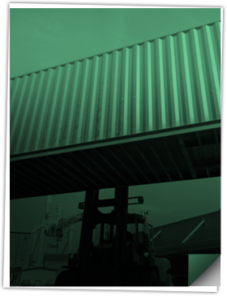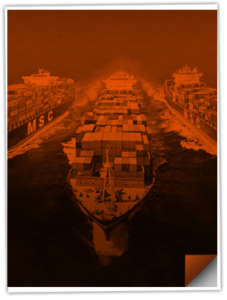Featured Headlines:
A Not-So-Short Debrief on Section 301 Exclusions for Certain Machinery
USDA Waves More Than a Grand of High-Flying AM7 Flags
Brazil's Ports Are Open for Business (and Bidding)
Rail-y Big News…CPKC and CSX Join Forces!
Boeing Blowing It?
- Despite historically high demand for air travel (is this still revenge travel?!) and the greedy and insatiable appetite of e-commerce for air cargo space, Boeing simply cannot get out of their own way. In Q3, the famous company lost over $6B on its dubious path to losing up to $35B over the last five turbulent years!
- We may not be ready for Prime Time, but we can evaluate Boeing’s struggles with a game called Rhyme Time:
- Growing? No! In a typical recent year, Boeing produces about 500 jets; they’ll be lucky to get to 400 in 2024. Like a private eye, the FAA is “watching you Boeing; they see your every move!”
- Flowing? Rather than looking ahead, the minimal safety performance of the Max, the 737 model which highlights Boeing’s safety crisis, is one giant bottleneck for Boeing’s global supply chain and future production schedule.
- Slowing? If anything, Boeing’s problems are speeding up; they currently face a labor strike. Hey, Boeing’s workers may not be manufacturing effectively, but at least they are unhappy not doing so!
- Crowing? This may the glimmer of hope we all want to see. Boeing has largely taken their failures right on the chin, and they have acknowledged that their top priority is to repair their company culture, returning to a stalwart emphasis on quality, controls, and (yes) profits.
- Globally, Airbus and Boeing manufacture up to 95% of the world’s airplanes with Airbus about 30-40% larger. As the world economy demands safety (!!), fuel efficiency, and greener fuel designs, Boeing must not fail!
- Not to be outdone, Airbus has a “max problem” with their A320neo model, and they have recently cut back severely on spending for their satellite business. Airbus is not stricken with Boeing’s dangerous “virus”, but they seem to have the “flu.”
- Boeing is America’s largest exporter and always ranks in the top 50 US companies. They estimate that 1.6 million workers generate $80B in economic activity from their 10,000+ suppliers in the US alone. Globally, these figures are off the charts!
- We may not trust an industry with just two (giant) players, and maybe that needs to change in future. However, one thing is clear… for now, we need to have sympathy for these two devils, even if they haven’t had much sympathy for themselves for years now.
The One-Two Vessel Bunch!
- According to the recent sea intelligence we see, unintelligent vessel bunching—a term used to describe multiple ships arriving at the same port within the same week—is back to pandemic levels and that ain’t braggin’!
- The primary and most obvious “bunch punch” is the ongoing interruption of access to the Suez Canal (courtesy of those cuddly Houthi rebels in Yemen). Ships have continued to re-route around the Cape of Good Hope for months—making the once-scenic route into the standard service that no one wanted!
- Lest you think this is a bunch of baloney (or Grandma’s ever-present “malarkey”), consider the child’s game, dominoes. Once the vessels bunch, cranes and trucks are in the crunch, on-time shipping is out to lunch, and on our freight budgets these inefficiencies do munch… and this is no hunch!
- While the Suez has delivered steady body blows for months, the second “bunch punch” was the brief but impactful uppercut of the ILA strike. In only three days, dozens of vessels backed up in US harbors putting more pressure on ports and creating bottlenecks for trucks, rail, barges, and warehouses.
- To emphasize the global nature of this game of dominoes, have a peek at PSA Singapore, which reports that 90% of ships have been tardy to the party-port (not to be confused with port-o-potty) of late, up from 77% last year. Officials have decided to reactivate older berths and add manpower to help fight the congestion.
- To properly digest this port punch party, consider that Singapore regularly witnessed on-time performance of above 80% before Covid. That’s a whole different kind of swing!
- Industry pundits, such as Sea Intelligence, are pulling no punches warning that there’s no sign of relief anytime soon—so brace yourselves for more shipping domino delays and gut punch congestion.
A Not-So-Short Debrief on Section 301 Exclusions for Certain Machinery
- In September, the office of the US Trade Representative (USTR) made several announcements related to its ongoing four-year review of Section 301 tariffs on certain products from China used in domestic manufacturing.
- As expected, the USTR has released further instructions on how importers can file an exclusion request on the applicable machinery products classified under the 312 HTSUS subheadings from Chapters 84 & 85 identified in Annex E of the original notice.
- Importers should take note of the following requirements prior to filing:
- Interested parties can submit an exclusion request between October 15, 2024 and March 31, 2025.
- Responses to individual exclusion requests are due 30 days after the request is posted on the USTR’s portal.
- Replies to any responses are due by the later of 15 days after the posting of a response, or 15 days after the closing of the 30-day response period.
- All requests, responses and replies need to be submitted online via the USTR portal.
- If granted, the tariff exclusion will become effective on the date of the publication in the Federal Register and will expire on May 31, 2025.
- The USTR is accepting exclusion requests on a rolling bases and will periodically announce decisions on the pending requests.
- Learn more about this announcement in the official notice published in the Federal Register (89 FR 83755).
USDA Waves More Than a Grand of High-Flying AM7 Flags
- Sounding slightly less exciting than a line straight out of George M. Cohan’s all American classic, the US Department of Agriculture (USDA) recently conducted a risk-based assessment to determine whether or not it should remove certain flags from its system.
- Following an analysis of the recovered data, USDA officials have decided to remove the AM7 flag from approximately 1700 Harmonized Tariff Schedule (HTS) codes in Chapters 53-94 respectively. The affected items are not directly related to organic food, feed, and/or textile products.
- The flags in question will be updated in production starting October 18, 2024. Once completed, CBP will send out a CSMS announcement to alert the trade community.
- You can learn more information about HTS codes—but less about the musical talents of Cohan—in CSMS # 62694995.
EU Tariff Tantrums Ring True
- European Central Bank (ECB) President Christine Lagarde has taken aim at potential US tariffs, stressing that international trade is a lifeline for growth, innovation, and productivity, not something to abandon.
- Forget playing at home—Lagarde says the US boomed when Wall Street traders reigned. Closing off borders…? That’s not exactly a winning strategy in Lagarde’s view.
- And a 60% tariff on Chinese goods? Economists are saying this could cause the biggest economic shock since people wore bell-bottoms unironically.
- As a stark example, European car sales are hitting the reverse button for the first time in two years. Blame inflation, tariffs, and an EV charging network growing so slowly it has people challenging the notion that the tortoise always wins the race!
- Volvo’s CEO says the car market is softening faster than overripe fruit, with slow EV infrastructure and tariffs throwing a wrench into the works…yuck.
- If that wasn’t enough, the International Monetary Fund (IMF) is giving the economy a solid “meh” for next year, in light of all the trade wars, actual wars, and violent weather events.
- This article is so bleak, we feel bad… so, we’ll end on a joke from an independent third-party candidate: “Knock, knock who’s there? Europe. Europe who? Europe to no good!”
Brazil's Ports Are Open for Business (and Bidding)
- Brazil is auctioning off 22 port concessions by next year, aiming for efficiency and private investment.
- A mixed bag of major assets (and Brazilian nuts) are now up for grabs, including a general cargo terminal at Itaguaí and a box terminal at Santos.
- President Lula is betting on modernizing domestic ports to keep Brazil competitive in the global trade game—and rake in some serious cash while doing it. The plan promises to boost the economy and create jobs in logistics and transportation—and who doesn’t love a win-win?!
- In the same vein, MSC has acquired Brazilian operator Wilson Sons via their subsidiary Shipping Agency Services.
- Some forwarders worry MSC’s acquisition will tip the scales too much in favor of carriers, pushing up rates. Meanwhile, others see partnership potential in MSC’s global network. Yet another mixed bag, you see! P.S. Does anybody really like Brazil nuts?!
Rail-y Big News…CPKC and CSX Join Forces!
- CPKC and CSX are rolling out a shiny new intermodal service, connecting Mexico to the Southeastern US. The Surface Transportation Board gave them the green light, so it’ll be all-aboard by year’s end!
- After buying up some lines in Alabama and Mississippi, these two rail giants are speeding headfirst to Atlanta—leaving trucking in the dust (or at least trying to).
- Although trucks might still have the edge, with faster times (3-4 days vs. 6-7), CPKC officials claim they’ll be “single-truck competitive” by Q1 of 2025.
- Pricing details are still hush-hush, until the other shoe drops on those pesky rail transit times. For now, truckers are the transit champs, although this rail route might just shake things up.
- Overall, the US rail industry still has some work to do to catch up with the speed of trucking, and intermodal rail assets are regularly in the wrong place at the wrong time, in part due to the seasonality of dominant domestic rail commodities. That said, rail is well positioned for environmental initiatives, lower average costs, and steady transit times.
Top Woes in Trucking
- The American Transportation Research Institute (ATRI) recently surveyed 3,700 stakeholders in the trucking industry to understand the trucking industry’s top concerns going into 2025.
- To no one’s surprise, once again, the economy is giving truckers’ optimism a flat tire and is the #1 rated issue across the board. The domestic freight industry’s slog through a two-year freight recession has everyone feeling deflated.
- Driving home a close #2, truckers are still hunting for a place to park. It’s like a game of musical chairs—only with 18-wheelers and 18-losers.
- Lawsuit abuse reform jumped to the #3 slot. Nothing like a legal scuffle to keep carriers on their toes.
- Rising insurance costs are hitting harder than potholes on I-95 for #4—just barely behind lawsuit abuse in the rankings (the two are related, of course though they claim to have no plans to see one another at Thanksgiving or even (gasp) Christmas!).
- Electrification of vehicles weighed in at #5. Battery-electric vehicles are gaining attention, but with higher costs, the industry is wondering if they’re the ticket or just a detour.



